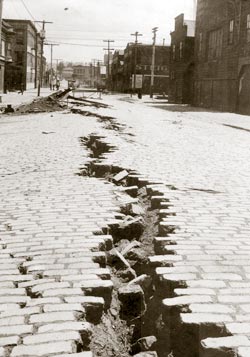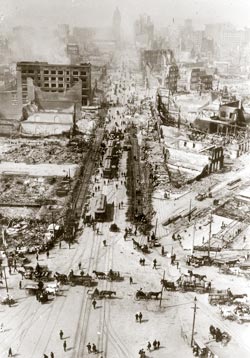100 years after the quake There still are lessons to be learned from the way Fireman's Fund handled claims By Phil Zinkewicz In 1936, MGM produced a film called “San Francisco,” starring Clark Gable, Jeanette MacDonald and Spencer Tracy. The film recreated, as closely as possible, the death and destruction that occurred 30 years earlier as the result of the San Francisco earthquake of 1906. Opening with the glitz and tawdry glamour of the Barbary Coast in the early part of the twentieth century, the film brings to life a world of drinking, gambling and dancehall girls—a sort of latter-day Sodom, where politicians took bribes to look the other way while builders constructed homes and commercial edifices with little or no safety standards or guidelines. The most memorable scenes are the ones in which the cameras follow Gable as he walks among the rubble caused by the earthquake and the fires engulfing the entire city. Gable watches in horror as buildings crumble, people are buried alive and streets split in half, becoming fiery crevices that swallow up residents running for their lives. This is the stuff that nightmares are made of. April of this year marked the 100th anniversary of the San Francisco earthquake. At a time when concern over natural catastrophes appears to be at its highest—Hurricane Katrina being the most recent example of the horrors that nature can inflict upon us—it might be pertinent to reflect upon the event of a century ago to remind ourselves of the necessity to be prepared for a similar occurrence. The Great San Francisco Earthquake of 1906 struck at 5:13 a.m. on April 18, waking up the city’s peacefully sleeping residents to the sounds of the city’s church bells set off by the quake. The quake was estimated at 8.5 on the Richter scale. The initial shock was felt from Coos Bay, Oregon, to Los Angeles and as far east as central Nevada. April 18 brought a total of 27 separate quakes, shaking the city throughout the day. The first lasted more than 40 seconds. The destruction extended from the southern part of Fresno County to Eureka, about 400 miles, and for a distance of 25 to 30 miles on either side of the fault zone. An estimated 225,000 people became homeless because of the disaster, leaving almost half of the city’s population of 400,000 to search for shelter. Initially, the death toll was put at 478 because it was thought that the announcement of a high death toll would hamper rebuilding and repopulation of the city. Reevaluation of the 1906 data in the 1980s put the death toll at more than 3,000. The fire that resulted from the quake covered 2,831 acres or 490 blocks. It burned for four days, until rain helped to extinguish it. The fire was six times the size of the Great London Fire of 1666 and three times the size of the Great Chicago Fire of 1871. The raging blaze consumed City Hall and its records, the libraries, the courts and jails, theaters, restaurants, 30 schools and 80 churches. Prominent families were ruined. All telephone and telegraph communications within the city were halted. The job of removing rubble from the city was enormous. About 15,000 horses were worked to death in the process. In clearing San Francisco, more material was moved than in the digging of the Panama Canal. Total property damage from the devastation in San Francisco was estimated at $400 million—the equivalent of more than $8 billion today. With the Kodak Brownie camera making photography a popular hobby for the first time in the early 1900s, the 1906 earthquake was the first widely photographed urban disaster.
An insurer’s challenge Those startling statistics and more can be found in the archives of the San Francisco based-Fireman’s Fund Insurance Company, available on the company’s Web site. Also on the Web site is a description of the steps Fireman’s Fund took, even in the wake of its own impending financial ruin, to assist claimants and to make the city whole. Fireman’s Fund’s headquarters at 401 California Street caught fire in the afternoon of that fateful April 18. The fourth floor collapsed onto the third level, causing a safe to fall onto the company’s vault. The impact broke a hole in the vault big enough to let the fire in, and every record of insurance in San Francisco was destroyed. One cashier and two marine surveyors were the only employees with authority to enter the building on the morning of the earthquake and try to save company documents. They loaded up the vault with as many maps and account books as it could hold. They carried the president’s desk across the street to the site of what was to become the new Bank of California building and covered it with canvas. The desk contained lists of stockholders and agents. These were the only records to survive. Fireman’s Fund operated a temporary headquarters at 10th and Broadway in Oakland. Rebuilding of the first three stories of the original headquarters in San Francisco began right after the fire. By the first week of July 1906, all departments—with the exception of the claims adjusters, who had set up shop in a flat on Turk Street—were back at 401 California. Claimants were given 120 days rather than the normal 60 days to file proofs of loss. Not until July of 1907 did reality hit: Fireman’s Fund’s losses were sure to exceed $11 million, a staggering sum in 1906. With responsibility to thousands of policyholders and hundreds of employees and stockholders in San Francisco, the insurer clearly had a problem. It had assets to pay its losses and enough left over to reinsure all its unburned risks. But before Fireman’s Fund could straighten out its books, every insurance commissioner in the country would shut the company down. It faced a situation similar to that of a bank facing a run. Something had to be done to head off panic. Acting with honor After much consideration and discussion with policyholders, industry leaders, and business and government officials, Fireman’s Fund engineered a financial plan that enabled it to honor all of its claims. It formed a new company—paying out all the cash the old firm had on hand—and offered policyholders stock in the new firm in lieu of cash they were owed. This payout, in turn, enabled individuals and companies to rebuild in San Francisco. S. H. Wolfe, a noted New York actuary who examined Fireman’s Fund’s books and reported to the California insurance commissioner in 1906, said: “It is difficult to imagine any institution being subjected to a more severe test than Fireman’s Fund Insurance Company. It has emerged with its reputation untarnished. The credit for this happy result belongs, in the great part, to the loyalty of the officers and employees and the remarkable plan of rehabilitating an institution, which had been practically wiped out by an unusual catastrophe. In the final summing, due credit must be given to the loyalty of the claimants of San Francisco who, united with the officers, prevented the extinction of a company, which had enjoyed so many years of honorable dealing with its policyholders.” One local newspaper in San Francisco had this to say: “Congratulations are coming to Fireman’s Fund on its decision not to contest claims for buildings dynamited to check the fire of last April. The position taken by the company is highly creditable. San Francisco is well aware of the difficult straits in which this corporation was placed after the great conflagration. The business suffered at both ends of the scale. Its losses on property insured were enormous, and the securities, in which the surplus and capital were invested, being mostly San Francisco enterprises, became badly depreciated owing to property losses in this city. It was a very trying position, and we rejoice to see that this long-established financial institution has got on its legs again, restored to health.” Lessons for today Christopher W. Heidrick, a Fireman’s Fund vice president who is responsible for the development of new products and services and the overall marketing strategy, says that the company sponsored a photo exhibit at the San Francisco Museum of Modern Art this past April in memory of the San Francisco earthquake. He talks about what we might learn from that devastating occurrence. “Those days, in 1906, were different times. While Fireman’s Fund is recognized as having done yeoman’s work in settling all claims and rebuilding its headquarters in the city while other insurance companies were paying fifty cents on the dollar and then packing their bags, one advantage the company had then was that insurance was a face-to-face business. Company records were destroyed, yes, but claims were paid by what people remembered and knew of one another. There was trust in the relationships. Today, everything seems to be off in a black hole. All the more reason for businesses to have business continuity plans in place, updated periodically. I think we have learned intellectually, but not as a society, the need for disaster preparedness. “Fireman’s Fund has demon-strated over and over that it recognizes it has a social responsibility to this city and to other cities where it operates,” Heidrick continues. “Our Heritage Program works to supply fire departments with what they urgently need—equipment and training. After the hurricane season of 2004, our company combined deductibles as we did after Katrina hit a year later. After the San Diego fires, Fireman’s Fund was able to cut through bureaucratic red tape and get the first permit to begin rebuilding. We have a stable and long-standing commitment to the insurance business and to the public. We believe it’s not just a business in which you play in and out games.” By all accounts, that commitment was impressively demonstrated after the San Francisco earthquake. * |
||||||
|




